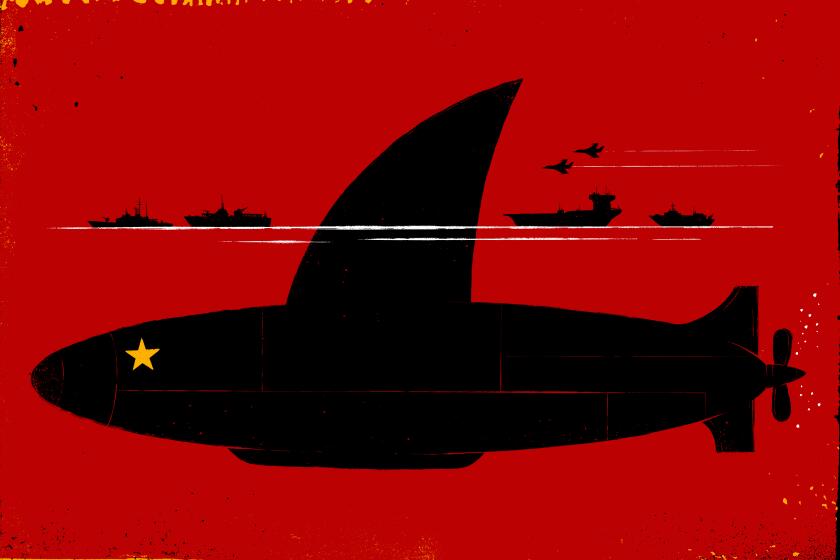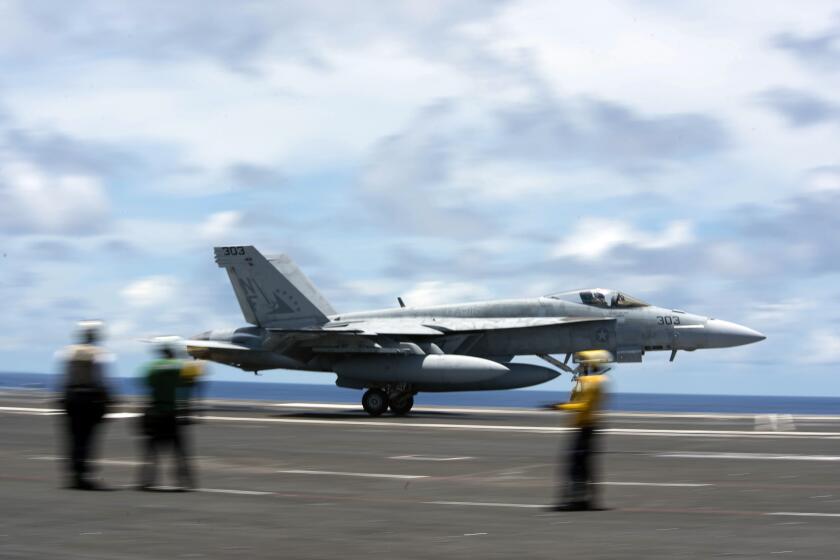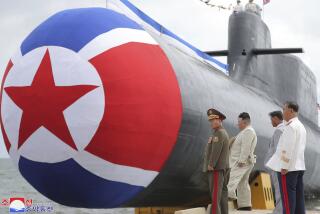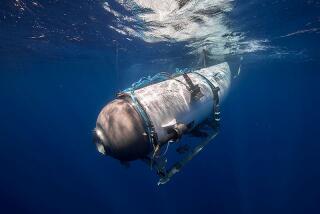Missing Indonesian submarine may be too deep to rescue
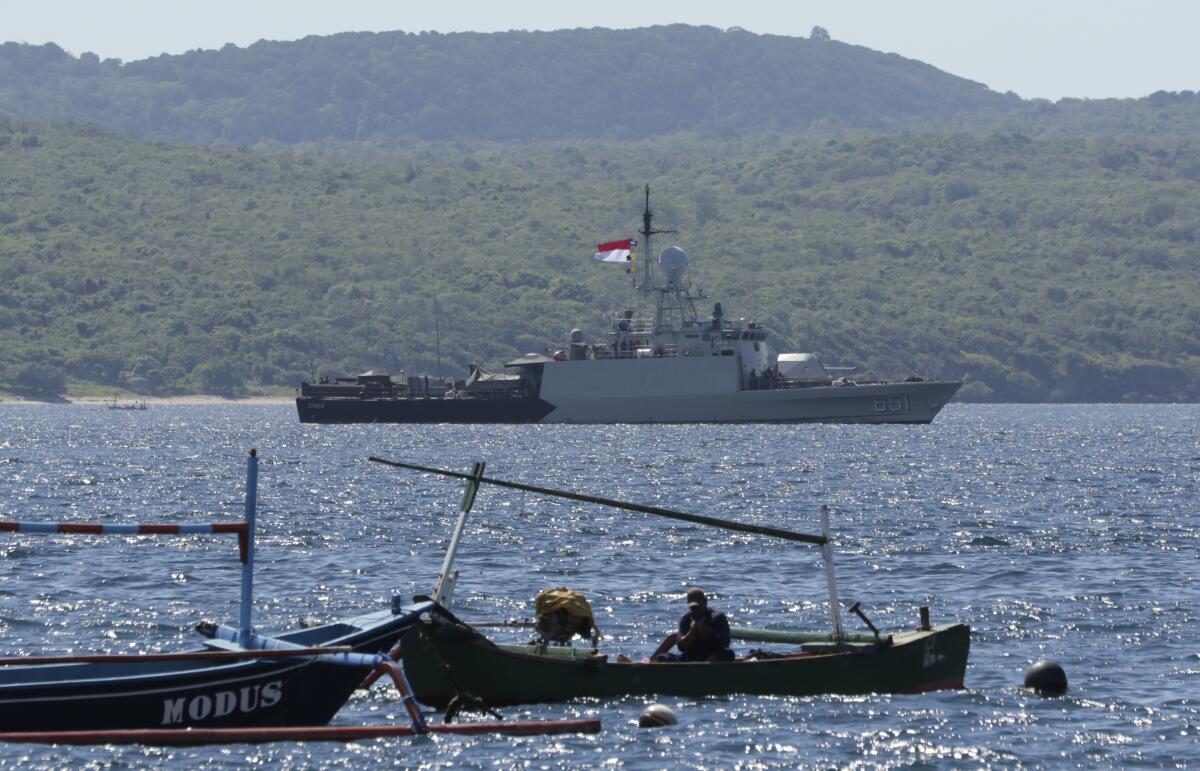
- Share via
JAKARTA, Indonesia — Indonesian naval ships Thursday were intensely searching for a submarine that likely sank too deep to retrieve, making chances of survival slim for the 53 people on board. Authorities said oxygen in the submarine would run out by early Saturday.
The diesel-powered submarine KRI Nanggala 402 was participating in a training exercise Wednesday when it missed a scheduled reporting call. Officials reported an oil slick and the smell of diesel fuel near the starting position of its last dive, about 60 miles north of the resort island of Bali, though there has been no conclusive evidence that they are linked to the submarine.
“Hopefully we can rescue them before the oxygen has run out” at 3 a.m. Saturday, Adm. Yudo Margono, the Indonesian navy’s chief of staff, told reporters.
He said that rescuers found an unidentified object with high magnetism in the area and that officials hope it’s the submarine.
The navy believes the submarine sank to a depth of 2,000 to 2,300 feet — much deeper than its collapse depth of about 656 feet, as estimated by a firm that refitted the vessel from 2009 to 2012. That means that the submarine would collapse if it goes deeper than that because of pressure, said Ahn Guk-hyeon, an official from South Korea’s Daewoo Shipbuilding and Marine Engineering. He said his company upgraded much of the Indonesian submarine’s internal structures and systems, but it lacks the latest information about the vessel.
Frank Owen, secretary of the Submarine Institute of Australia, also said the submarine could be at too great a depth for a rescue team to operate.
Beijing’s aggressive South China Sea expansion shows its willingness to defy international laws for President Xi Jinping’s visions of power.
“Most rescue systems are really only rated to about 600 meters,” or 1,969 feet, he said. “They can go deeper than that because they will have a safety margin built into the design, but the pumps and other systems that are associated with that may not have the capacity to operate. So they can survive at that depth, but not necessarily operate.”
Owen, a former submariner who developed an Australian submarine-rescue system, said the Indonesian vessel was not fitted with a rescue seat around an escape hatch designed for underwater rescues. He said a rescue submarine would make a waterproof connection to a disabled submarine with a so-called skirt fitted over the rescue seat so that the hatch can be opened without the disabled submarine filling with water.
Owen said the submarine could be recovered from 1,640 feet without any damage but couldn’t say if it would have imploded at about 2,300 feet.
In November 2017, an Argentine submarine went missing with 44 crew members in the South Atlantic, almost a year before its wreckage was found at a depth of 2,625 feet. In 2019, a fire broke out on one of the Russian navy’s deep-sea research submersibles, killing 14 sailors.
Three American aircraft carriers are patrolling Indo-Pacific waters in an unusual naval buildup as tensions rise between the U.S. and China.
Indonesian President Joko Widodo asked his compatriots to pray that the submarine and crew would be found.
“Our main priority is the safety of the 53 crew members,” Widodo said in a televised address. “To the families of the crew members, I can understand your feelings, and we are doing our best to save all of the crew members on board.”
Indonesia’s military said Thursday that more than 20 navy ships, two submarines and five aircraft were searching an area where the submarine was last detected. A hydro-oceanographic survey ship equipped with underwater-detection capabilities also was on its way to the site around the oil spills.
Margono said the oil slick may have been caused by a crack in the submarine’s tank after the vessel sank.
Breaking News
Get breaking news, investigations, analysis and more signature journalism from the Los Angeles Times in your inbox.
You may occasionally receive promotional content from the Los Angeles Times.
Neighboring countries were joining the complex operation.
Rescue ships from Singapore and Malaysia are expected to arrive between Saturday and Monday. The Indonesian military said Australia, the U.S., Germany, France, Russia, India and Turkey have also offered assistance. South Korea said it has also offered help.
“The news of the missing submarine is deeply concerning,” Australian Foreign Minister Marise Payne said during a visit to New Zealand. “We will provide any assistance that we can. There’s no question that submarine search and rescues are very complex.”
Australian Defense Minister Peter Dutton called the incident “a terrible tragedy.” He told Sydney Radio 2GB the fact that the submarine is “in a very deep part of waters” makes it “very difficult for the recovery or for location.”
Indonesia’s navy said an electrical failure may have occurred during the dive, causing the submarine to lose control and become unable to undertake emergency procedures that would have allowed it to resurface. It was rehearsing for a missile-firing exercise Thursday, which has been canceled.
The German-built submarine, which has been in service in Indonesia since 1981, was carrying 49 crew members, its commander and three gunners, the Indonesian Defense Ministry said. It had maintenance and overhaul in Germany, Indonesia and most recently in South Korea, from 2007 to 2012.
More to Read
Sign up for Essential California
The most important California stories and recommendations in your inbox every morning.
You may occasionally receive promotional content from the Los Angeles Times.
